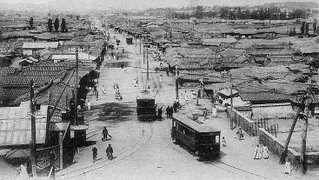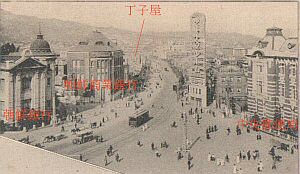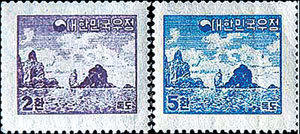A quick look at these pages (here and here), however, will reveal a series of photos you may feel you've seen before. Almost every photo in this Occidentalism post 'proving' how backwards Korea was before the Japanese colonial period (including the before and after shots of Namdaemun with the red Hanja written over them) can be found there. In addition, this page, showing Korean copies of Japanese products, features many of the same photos found in the post "Koreans - Original?", which I find a little humourous considering it's just a cut and paste of photos from Japanese websites, which I would hardly consider to be original (More blatant would be the use of Tokyo University education professor Fujioka Nobukatsu's work exposing fabricated WWII-era photos - compare the originals (here and here - sorry, they're cached) with these posts (here and here) - which make no reference to the original source). And lastly, speaking of uncredited original sources, I wasn't surprised to read, over at Scott Bug's website, that Occidentalism had Kushibo and Nora Park's similarities pointed out to him by someone else. When I originally read the expose, I thought, what with the variety of sources and the convincing proof, "How did he pull that off?" Now I know - another unattributed source. You'd think that leaving a "hat-tip to reader" for a juicy scoop like that (even if the source wished to remain anonymous) would just be common courtesy.
But I digress...
Now, as I mentioned, most of the photos that make up the post that introduced me to Occidentalism, The Japanese Administration of Korea, can be found here and here (and of course, I posted a counterargument to many of the single-sentence assertions made in that post quite some time ago). As this post is essentially a cut and paste job, translating revisionist photo collections from Japanese websites into English, it's quite interesting to look at the originals and see what a shoddy product Occidentalism's readers were sold.
When I first saw this photo of Tokyo in that post, I couldn't help but wonder where in Tokyo it was and when it was taken (even though it says the 1850s). A few months ago I came upon a photo of Edo and thought it looked familiar. I soon realized that the "1850s" Tokyo photo that appears in "The Japanese Administration of Korea" is in fact the far left section of this panoramic photo of Edo (click to enlarge):

Now, this wikipedia entry tells us that it was taken by Felice Beato in 1865 or 1866, and that it shows daimyo residences (there's a cleaned up and colorized version here). One would assume that the feudal lords of Japan would probably be living in a rather upscale part of Edo, if not one of the richest parts of the city, housed as they were in 'lavish residences.' So an appropriate comparison would be one of the richest areas in Seoul, say, near Kyongbok Palace and the areas where many government ministers lived.

Of course, this is not the comparison Occidentalism chose to make. Instead we're given the photo below with a caption reading "The center of Seoul, Namdemun, Circa 1880. Thatched buildings and shops." Besides the obvious point that a gate along the wall surounding the city can hardly be called the center of the city, there's another problem with this photo - it's actually looking southward, out of the city. As there was really only one long road approaching Namdaemun from either side at that time it's easy to compare the two sides. Look at the 3rd and 4th photos on this page - the 3rd is the photo below, looking south, and the 4th is Namdaemunro, which runs northeast. You can't mix them up, so this photo is actually, again, looking out of the city (into an area where merchants and the lower classes lived):


Any doubt about this is removed by the photo above. A quick glance makes it clear that it is the exact same view as the photo above (they're likely taken 20 or so years apart). This site, where I found it, labels it (via autotranslation) as an example of the what Seoul looked like during the Japanese period, the implication being that the Japanese improved the area a great deal. What's humorous about this is that the photo above could not have been taken any later than mid 1911, because the street from Namdaemun to Seoul Station was widened at that time (and made twice as wide as it appears in this photo - as this view of the same street taken in the 1920s makes clear). The fact that there are streetcar tracks on the street makes clear that it could only be looking south, as the other smaller streets that radiated out from Namdaemun didn't have streetcar lines on them until after 1911.
To restate things, then, one of the richest areas in Edo is being compared to a poor area outside of Seoul's city walls. It really isn't difficult to demonstrate that Seoul was not as developed or wealthy as Tokyo was; the use of such an unfair comparison shows either a desire to mislead, or a complete ignorance of the cities being compared.
A look through this Japanese webpage reveals numerous folk customs and superstitions. Two of these photos were used in "The Japanese Administration of Korea". This one, showing the sole of a bare foot with writing on it, is followed by this discription: "Before the Japanese introduced medicine in Korea, Koreans would cure Malaria by writing their names on their feet." One of the errors in this description is that it was not the Japanese who introduced modern medicine to Korea, but western missionaries (I wrote about the experiences of missionaries in Pyongyang in the 1890s here, for example).
We're then shown this photo:

It's description: "Pre-Japanese era Korean medicine. This childs parents are trying to cure this childs disease by throwing away this straw doll. Various diseases could be ‘cured’ by this ‘method’. The average Korea lifespan at this time was around 24 years old. Thanks to Japanese investment in medicine and nutrition in Korea, the lifespan went up to nearly 50 years old by the end of WW2."
Yes, while the missionaries may have introduced modern medicine, the Japanese would have had the means to allow for the treatment of far more people, especially through innoculation. Introducing water systems in the cities, as well as other sanitation programs, also would have done a great deal to help increase lifespans. Despite this, I doubt that the bulk of the population who lived in the countryside, where education and health facilities were often lacking, would have seen the same benefits those living in cities did. The ignorance of those from the country and their mistaken views of 'modern medicine' are well illustrated in Kim Yu-jeong's mid 1930s short story "The Scorching Heat" (scroll down to find the pdf). In it, a man, whose wife has had a miscarried fetus caught inside her for months, believes that they will be paid by the hospital to study her strange condition. Instead they are laughed at, and the woman chooses to die rather than be 'cut open'. The story makes clear how alien (and terrifying) the hospital seems to them.
It might, however, also be worth examining the phrase "Pre-Japanese era Korean medicine." First of all, the pictures shown above, are, in fact, shamanic or folk traditions, and are quite different from Hanyak, which is derived from the Chinese medical tradition. As Paul S. Crane describes in Korean Patterns,
In addition to orthodox Hanyak, there are "people's remedies" and women practitioners who specialize in driving out evil spirits, which are believed to cause disease. By beating drums, burning incense, and chanting holy incantations, these sorceresses, or mudang, attend the sick.[...] These "people's remedies" are not a part of formal Hanyak, but are part of the treatment one may receive in the villages from unlicensed practitioners.Second of all, these photos are not pre-Japanese at all. A look at this website introduces us to the photos of Murayama Chijun (I keep needing to change the character encoding on that site to Korean (EUC-KR); also, the thumbnail links don't work). Murayama took numerous photos of Korean rituals and traditions in the 1920s and 1930s, and in the chapter "Spirits in Daily Life", the photos used in the Occidentalism post are clearly seen. Call me old fashioned, but I don't think using photos of pre-modern superstitions taken 15 to 25 years after Japan began administering Korea does much to prove that Japan spread the benefits of modern civilization throughout Korea. To go further, it's quite possible that the situation of the ignorant couple that Kim Yu-jeong described in his story was the norm in many parts of the country during the colonial period, especially considering that the "people's remedies" Paul S. Crane described were still relatively common in the 1950s and 1960s.
And a quickie about this photo:

It's labeled as being Pyongyang, but, as the photo below makes clear, it's actually a photo of Namdaemunro in Seoul, and is likely taken from the top of the Mitsukoshi department store. The giveaways are the Bank of Korea building on the left, and the central post office on the right.

The above mistakes illustrate one of the weaknesses of the internet age, especially regarding photos. Often, once a photo is posted somewhere with a mistaken caption, it just gets passed on and on throughout the internet, as the same photos are reused on countless different sites. Historical photos are especially prone to this, and the Occidentalism posts I described above using Fujioka Nobukatsu's work exposing fabricated WWII-era photos should get more publicity - the Korean and Chinese sites using them do themselves and their readers no favours by using false 'proof' (even in ignorance) to support their points of view (no more than Occidentalism does).
Also, close-minded nationalists (in this case a group of Korean netizens) aren't doing anyone any favours by shutting down the discussion of viewpoints they don't like - case in point (I just noticed this a moment ago) organizing a campaign to target Gerry Bevers' employers in order to force him to stop writing about Dokdo. It goes to show the ire that can be raised by a person who uses lots of attributed sources and who can actually make a strong argument - something rarely seen during Occidentalism's first year.
Oh, as this pertains to the last two paragraphs, some may find it interesting: A set of stamps apparently released in 1954, the year South Korea seized Dokdo. As for another Korean government project regarding Dokdo, do read this fascinating comment over at the Marmot.


Great post, Matt! I find much better history here than I do at Frong in a Well - Korea. Though that site occasionally offers up good fare.
ReplyDeleteThanks, though to be fair to Frog in a Well, I imagine those in academia have more commitments pressing on their time than I do (as well as having another outlet for publishing).
ReplyDeleteI flipped through my archives last night and noticed that my focus has changed from current, media driven "gusts of feeling" and more recent history, to urbanism in Seoul and late 19th century and colonial period Korea - which is likely due to my first response to the Occidentalism post I analyzed here, which had me concentrating a great deal on both topics. So perhaps I should thank Matt for his provocation...
I'd like to second Lirelou's comments. I've really enjoyed reading your posts on Korean history, and I appreciate the effort you go through to dig up old photos to help tell your story. I recently completed Three Generations, too, and had a lot of fun reliving the book through your photo tour of the story.
ReplyDeleteThanks, I'm glad the Three Generations post was useful for someone who'd read the book! I actually need to update that post, as I found a few new photos and realized that the location of Jingogae on my map was a bit off. I'll get to that tonight, maybe.
ReplyDeleteHi Matt, I just noticed this -
ReplyDelete"For the record -- and you heard it here first -- Occidentalism was in fact tipped off about the true identity of "Nora Park" by a personal acquaintance and old-school Korea expat who smelled a garlicky rat and hacked into the email accounts of both Kushibo and "Nora Park," discovered that their passwords were identical and found enough incriminating evidence to convince Occidentalism to go public with the story."
It took me two months to write the expose about Kushibo, including numerous mails to other bloggers ect. If someone else is claiming credit for my work, I want them to come forward so I can smack them in the head.
By the way, I can foward you copies of such emails so you can see exactly how I worked it out.
ReplyDelete